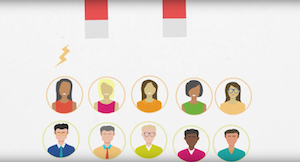
Connectivity and hardware
Two challenges emerged for families and schools as they embarked on a crisis response and began distance learning: hardware and connectivity.If one-to-one technology is out of reach (and with budget uncertainty looming, it well could be), schools can still figure out what is possible. Equity doesn’t mean everyone gets the same thing. It means everyone gets what they need to succeed. If students already have access to a reliable device they don’t need to share among siblings and family members, they might not need a school-issued device.
This experience has proven even more starkly that high-speed connectivity isn’t a privilege —it’s necessary to learning. Students need adequate connectivity to participate in a video-based chat or lecture. Schools have created a scaffolding solution by distributing mobile hotspots to students who lack connectivity.
One large perception shift needs to occur in this realm. Many student devices come hardwired with limitations designed to save kids from themselves. These boundaries must shift from limiting kids based on what some might do (use a school-issued device to stream entertainment during downtime) to safety. By all means, block sites which are harmful to students and devices, but ensure those limitations don’t impair students from participating to the extent their peers who have home-based connections can. This includes capping data at a low level, which precludes students from joining required video conferences.
This crisis response has made it clearer than ever that a strong IT team is crucial to the success of schools. IT pros in schools have transitioned from working hard behind the scenes to the front lines of education. It’s important they have the support they need to keep good communication flowing between schools and homes. They can explore surveys, webinars, and recorded training sessions to ease the stress of constant questions.
Assignments, standards, and grading
The current remote learning strategy is based on crisis response. As curriculum pros embark on planning during the summer, they can be more deliberate about decisions and how to structure remote learning.Prioritization can help structure shifts between in-person and distance learning. Certain assignments may be more manageable than others outside the classroom. As schools narrow in on what belongs in which setting, it can reveal opportunities for student agency through project-based learning.
The most difficult divide, even surpassing the connectivity divide, lies between early childhood and students who have mastered reading. Early learners, along with their parents, face a very different form of remote learning. This is one of the trickiest age groups to move outside a classroom setting and may need to be kept in school as a first priority if possible.
Schools will need to identify a trustworthy assessment and employ it as often as appropriate to keep students on track. Measuring progress often and mastery at specific, pre-determined times has always been the rule of thumb. Teachers may measure progress in remote settings through video call conferences, journal entries, and rubrics which break learning down into steps.
Interoperability helps districts transition smoothly to remote learning. The ability to quickly and easily share assignments and grading data between a learning management system and a student information system, whether it's because they're one shared system or through an API, will simplify the process of teaching and learning.
Grades themselves present yet more questions. Schools have already started to experiment with alternative methods of grading. It may be time to explore non-traditional methods of measuring mastery. One silver lining of this remote learning shift: parents are open to change because “the way we’ve always done it” inertia is no longer an option.
Teaching staff
Teachers have jumped so many cords and completely re-constructed school on a moment’s notice. Now that we’ve acknowledged that supreme feat, solidifying a strategy for the 2020-21 school year is of premium importance so every day doesn’t have to be a brain-draining improv show.Again, as budgets are uncertain, it’s not clear whether schools can hire additional help from remote tutors, coaches, or additional teachers. But other qualified adults may be available to help take some pressure off individual teachers. Districts in Illinois, for example, have found relief from retired teachers who stepped up to support students and staff.
Other options to support staff include remote teaching and learning webinars for PD. These are popping up in response to the current crisis. Tap your IT team to create district-specific webinars and training for your chosen edtech solutions. This is an investment in security, too. If teachers can lean on the existing solutions you have in place, they’re less likely to choose unvetted options to quickly solve a pressing problem.
Mental health
Among the challenges COVID-19 response has brought, trauma is one every student and staff member is dealing with in different ways and to different degrees. The sudden disruption of routine has impacted every student, and if the experience is repeated it will bring those same feelings to light again.This is a great time to implement a trauma-informed response to teaching and learning. When students are struggling to keep order in the bottom tiers of Maslow’s Hierarchy of Needs, they are not prepared to learn in leaps and bounds. That’s okay for now.
Speaking of that hierarchy, emphasizing a sense of belonging has been top-of-mind for many educators working remotely. Video conferencing is absolutely advanced, but not yet able to replicate the feeling of interacting with classmates and teachers. Counselors are also grappling with an increased workload despite already being outnumbered in most districts. Remote learning strategy must account for relationships to form and continue between support staff and students as well as teachers.
It’s easy to get bogged down listing things we wish were different with our remote teaching experience. The good news is, now there’s an opportunity to create a strategy going forward knowing what we have learned from a crisis response. Remote learning isn’t only an emergency requirement—a good strategy could make a world of difference for students who aren’t able to join their peers for many reasons.
If there’s a silver lining, it’s the chance to increase equity for as many students as possible.
Follow-up resource: Be ready for remote learning
Check out this round-up of free, useful remote learning resources.WHAT'S NEXT FOR YOUR EDTECH? The right combo of tools & support retains staff and serves students better. We'd love to help. Visit skyward.com/get-started to learn more.

|
Casey Thompson Edtech Thought Leader |




